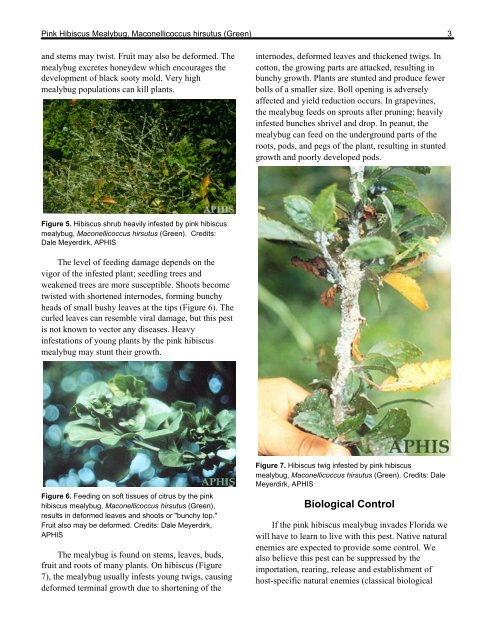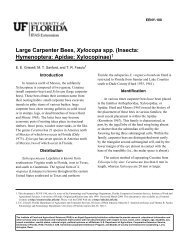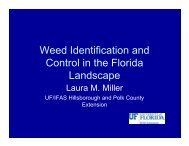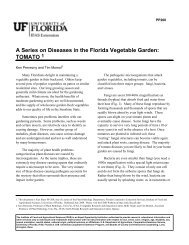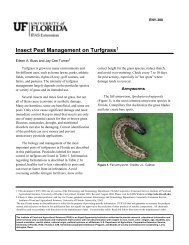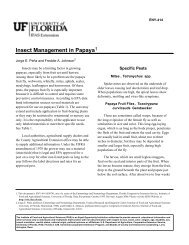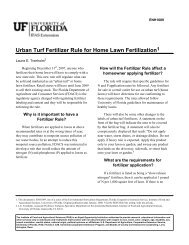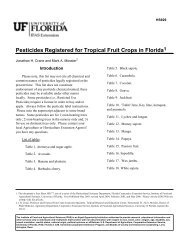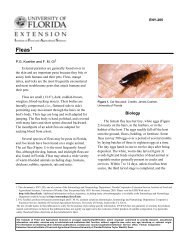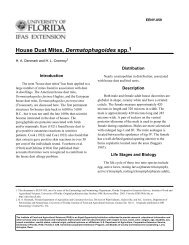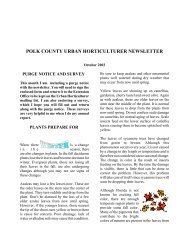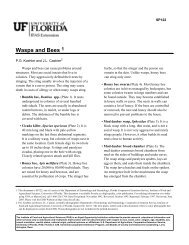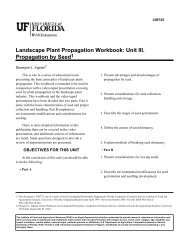Pink Hibiscus Mealybug, Maconellicoccus hirsutus - Polk County ...
Pink Hibiscus Mealybug, Maconellicoccus hirsutus - Polk County ...
Pink Hibiscus Mealybug, Maconellicoccus hirsutus - Polk County ...
Create successful ePaper yourself
Turn your PDF publications into a flip-book with our unique Google optimized e-Paper software.
<strong>Pink</strong> <strong>Hibiscus</strong> <strong>Mealybug</strong>, <strong>Maconellicoccus</strong> <strong>hirsutus</strong> (Green) 3<br />
and stems may twist. Fruit may also be deformed. The<br />
mealybug excretes honeydew which encourages the<br />
development of black sooty mold. Very high<br />
mealybug populations can kill plants.<br />
internodes, deformed leaves and thickened twigs. In<br />
cotton, the growing parts are attacked, resulting in<br />
bunchy growth. Plants are stunted and produce fewer<br />
bolls of a smaller size. Boll opening is adversely<br />
affected and yield reduction occurs. In grapevines,<br />
the mealybug feeds on sprouts after pruning; heavily<br />
infested bunches shrivel and drop. In peanut, the<br />
mealybug can feed on the underground parts of the<br />
roots, pods, and pegs of the plant, resulting in stunted<br />
growth and poorly developed pods.<br />
Figure 5. <strong>Hibiscus</strong> shrub heavily infested by pink hibiscus<br />
mealybug, <strong>Maconellicoccus</strong> <strong>hirsutus</strong> (Green). Credits:<br />
Dale Meyerdirk, APHIS<br />
The level of feeding damage depends on the<br />
vigor of the infested plant; seedling trees and<br />
weakened trees are more susceptible. Shoots become<br />
twisted with shortened internodes, forming bunchy<br />
heads of small bushy leaves at the tips (Figure 6). The<br />
curled leaves can resemble viral damage, but this pest<br />
is not known to vector any diseases. Heavy<br />
infestations of young plants by the pink hibiscus<br />
mealybug may stunt their growth.<br />
Figure 6. Feeding on soft tissues of citrus by the pink<br />
hibiscus mealybug, <strong>Maconellicoccus</strong> <strong>hirsutus</strong> (Green),<br />
results in deformed leaves and shoots or "bunchy top."<br />
Fruit also may be deformed. Credits: Dale Meyerdirk,<br />
APHIS<br />
The mealybug is found on stems, leaves, buds,<br />
fruit and roots of many plants. On hibiscus (Figure<br />
7), the mealybug usually infests young twigs, causing<br />
deformed terminal growth due to shortening of the<br />
Figure 7. <strong>Hibiscus</strong> twig infested by pink hibiscus<br />
mealybug, <strong>Maconellicoccus</strong> <strong>hirsutus</strong> (Green). Credits: Dale<br />
Meyerdirk, APHIS<br />
Biological Control<br />
If the pink hibiscus mealybug invades Florida we<br />
will have to learn to live with this pest. Native natural<br />
enemies are expected to provide some control. We<br />
also believe this pest can be suppressed by the<br />
importation, rearing, release and establishment of<br />
host-specific natural enemies (classical biological


